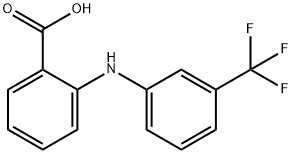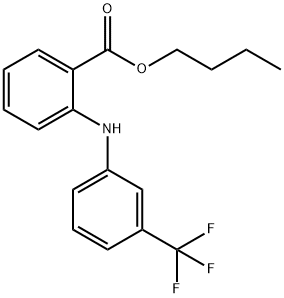Flufenamic acid , 98% , 530-78-9
Synonym(s):
N-(α,α,α-Trifluoro-m-tolyl)anthranilic acid;N-(3-[Trifluoromethyl]phenyl)anthranilic acid
CAS NO.:530-78-9
Empirical Formula: C14H10F3NO2
Molecular Weight: 281.23
MDL number: MFCD00002422
EINECS: 208-494-1
| Pack Size | Price | Stock | Quantity |
| 5g | RMB74.40 | In Stock |
|
| others | Enquire |
PRODUCT Properties
| Melting point: | 132-135 °C(lit.) |
| Boiling point: | 373.9±42.0 °C(Predicted) |
| Density | 1.3380 (estimate) |
| vapor pressure | 0Pa at 25℃ |
| storage temp. | Keep in dark place,Inert atmosphere,Room temperature |
| solubility | soluble in organic solvents such as ethanol, DMSO, and dimethyl formamide. The solubility of flufenamic acid in these solvents is approximately 11, 39, and 59 mg/ml, respectively. |
| pka | pKa 3.9 (Uncertain);3.85 (Uncertain) |
| form | Crystalline Powder or Chunks |
| color | Off-white to gray-green |
| Water Solubility | 0.0265 g/L (37 ºC) |
| Merck | 14,4132 |
| BRN | 1996069 |
| LogP | 5.25 |
| CAS DataBase Reference | 530-78-9(CAS DataBase Reference) |
| NIST Chemistry Reference | Flufenamic acid(530-78-9) |
Description and Uses
Flufenamic acid (FFA), namely N-(alpha,alpha,alpha-trifluorom-tolyl) anthranilic acid (CI-440), is an aromatic amino acid consisting of anthranilic acid carrying an N-(trifluoromethyl)phenyl substituent. It is an effective drug in the treatment of special types of migraine. Its anti-inflammatory and analgesic effects were recognized in the 1960s (Winder et al., 1963) and thus FFA is included in the family of non-steroidal anti-inflammatory drugs (NSAIDs) with mefenamic, meclofenamic (MFA) and niflumic acids (NA). Anti-inflammatory actions occur mainly through reduction of prostaglandin synthesis from arachidonic acid by inhibiting the cyclo-oxygenases.
Flufenamic acid is used for moderate pain and dysmenorrhea, but it should not be used for more than 1 week due to the possibility of nephrotoxicity, gastrointestinal toxicity, and anemia. It is frequently used in combination with the anticoagulant warfarin, the effect of which is strengthened when combined with flufenamic acid.
Safety
| Symbol(GHS) |  GHS06 |
| Signal word | Danger |
| Hazard statements | H301-H315-H319 |
| Precautionary statements | P301+P310+P330-P302+P352-P305+P351+P338 |
| Hazard Codes | Xn |
| Risk Statements | 22-36/38 |
| Safety Statements | 26 |
| RIDADR | UN 2811 6.1/PG 3 |
| WGK Germany | 3 |
| RTECS | CB4375000 |
| HazardClass | 6.1(b) |
| PackingGroup | III |
| HS Code | 29224999 |
| Toxicity | LD50 in mice: 715 mg/kg orally (Zoni) |




